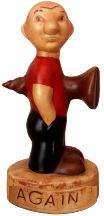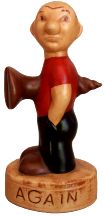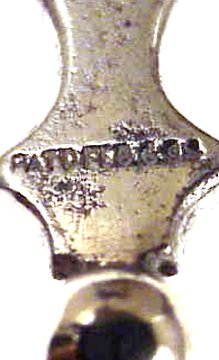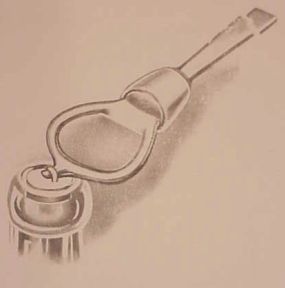 |
 The Virtual Corkscrew Museum's Daily Newspaper |
 |
 |
 The Virtual Corkscrew Museum's Daily Newspaper |
 |
|
Saturday, February 7, 2004 |
Part 2 of 3 parts
Who Invented the Crown Cap Lifter?
The Bottle Opener
Wirtz, Virginia - The third "Bottle Sealing Device" patent issued to William Painter on February 2 (Number 468,259) had an earlier filing date of November 5, 1899 with a renewal date of October 6, 1891. This patent dealt with a cap which had a loop formed in the sheet metal top. By inserting a pointed instrument into this loop the cap could be forced off.
In this patent Painter also provides for the use of a cork and a corkscrew. He writes: "My sealing caps possess much practical value for use in connection with long corks ... and by having a small hole in the center of the cap, as indicated in dotted lines in Fig. 1 (below), a corkscrew can be inserted for simultaneously withdrawing the cork and removing the cap."
An interesting addition to the patent drawings is Figure 12 which Painter says "Illustrates a tool devised for use as a hand-lever for wrenching the sealing-caps from bottles." Although the round loop at the top of the handle is not designed for prying off a cap, it certainly is a sign of things to come.
After William Painter patented his "Crown Cork", he founded Crown Cork and Seal Company in the Canton area of Baltimore, Maryland. He developed machinery for production and implementation and then set about the task of marketing the idea. An advertisement in the September 15, 1894 issue of the Western Brewer showed a variety of ways to remove the crown cork including using a corkscrew tip, a pocket knife blade and a spoon handle. These were some of the thoughts expressed in Painter's bottle sealing device patent applications.
How many of the huge number of corkscrews with tipped worms and knives with broken blades that turn up were used in failed attempts to remove a crown cap?
In his crown cap patents Painter said he would be filing applications for his bottle opener. On June 5, 1893 he fulfilled his promise and filed an application for the "Capped-Bottle Opener." Note that the 1892 patents were in his name only whereas this new application assigned the patent to the Crown Cork and Seal Company. His claim was:
"A capped bottle opener consisting of a suitable handle, provided with a cap engaging lip adapted to underlie a portion of an applied bottle sealing cap, and also having a centering gage affording gaging contact with the side of the cap adjacent to the engaging lip, and still farther affording fulcrum contract to enabling better engagement with the upper portion of the cap."
On February 6, 1894 his invention was assigned United States Patent Number 514,200. Painter succeeded in developing a system for sealing bottles and now had the perfect method for removing the seal. Both of his ideas would change the way beverages were marketed for decades to come.
William Painter
1838-1906
The tough job now was to convince brewers and bottlers to use the Crown Cork. His invention was eyed with skepticism. How would the beverage react to the cork? How long would it keep? To prove that the Crown Cork was the best bottle closure, Painter sent some bottle beer sealed with Crown Corks on a ship from North to South America. When the ship arrived, the beer had not lost its flavor. Some brewers and bottlers began to convert to his system. Others were still skeptical. Even Milwaukee brewing giant Pabst was not willing to accept this new fangled idea. They continued to cork their beer until 1910.
The company grew quickly, and by the time of Painter died in 1906, the company had plants in Europe, Asia, and South America. By the time the 1930s rolled around, Crown Cork and Seal was producing half of the world’s supply of bottle caps.
In 1908 a crown cap lifter was produced with an ornate silver handle. Interestingly it depicted a hand holding a corkscrew pulling a cork from a bottle. The cap lifter is marked PATD FEB 6 94

Just because the Crown Cork was being produced, it did not mean the end of other methods of sealing bottles. In order to make the Painter style cap remover more useful, early examples were produced with other functions. In the following cuts from Crown Cork and Seal advertisements we see the opener / bottle stopper combination, the loop seal remover, the aluminum stopper remover, and the Crown Cork remover.

Now a corkscrew had to have an added dimension. The cap lifter began to show up in many corkscrew patents as an accessory.
_____________________________________________
Tomorrow in Part 3: "The Competition."
Follow-Up
In the January 5 issue Chris Williams pondered "I would like to hear from your readers the excuses for broken tips to corkscrews, anything from chopping ice to opening beer bottles."
We suspect a good number of them were broken through use on crown caps.
E-Z Cork Puller
In the February 4issue we asked "Any readers ever seen an E-Z Cork Puller with advertising on the handle?" Reader Bob Bortfeld writes:
Here is my E-Z Cork Puller which advertises "H. Nagata Store" in Paia, Maui, T.H. (Territory of Hawaii). The store is still there and this opener dates from WWII. We got this at a flea market on Maui in 1999.
|
©2004 Don Bull, Editor |